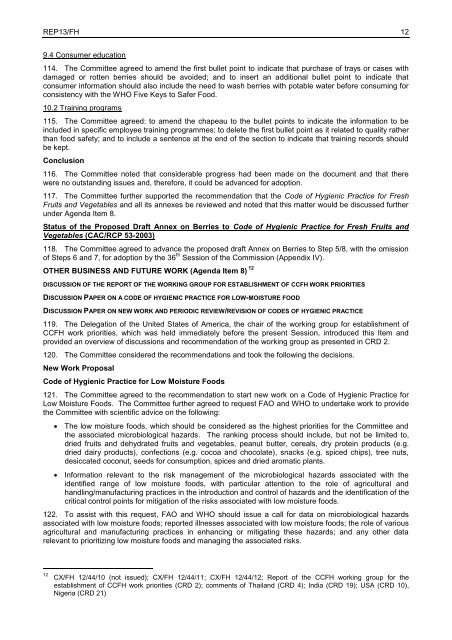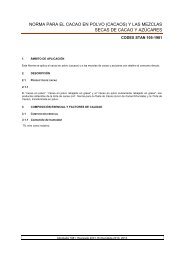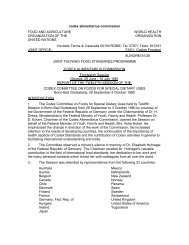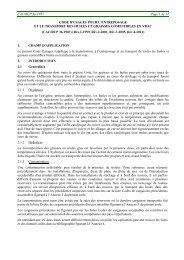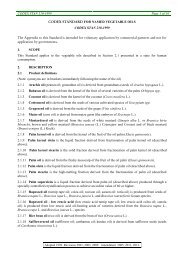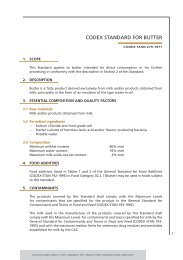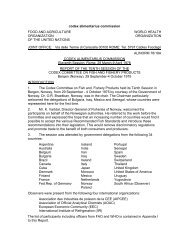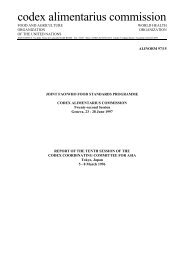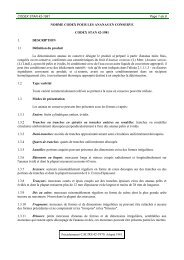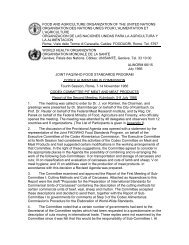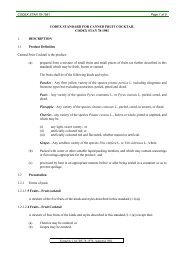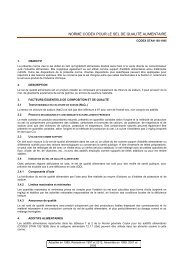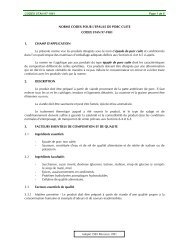REP13/FH JOINT FAO/WHO FOOD STANDARDS PROGRAMME ...
REP13/FH JOINT FAO/WHO FOOD STANDARDS PROGRAMME ...
REP13/FH JOINT FAO/WHO FOOD STANDARDS PROGRAMME ...
Create successful ePaper yourself
Turn your PDF publications into a flip-book with our unique Google optimized e-Paper software.
<strong>REP13</strong>/<strong>FH</strong> 12<br />
9.4 Consumer education<br />
114. The Committee agreed to amend the first bullet point to indicate that purchase of trays or cases with<br />
damaged or rotten berries should be avoided; and to insert an additional bullet point to indicate that<br />
consumer information should also include the need to wash berries with potable water before consuming for<br />
consistency with the <strong>WHO</strong> Five Keys to Safer Food.<br />
10.2 Training programs<br />
115. The Committee agreed: to amend the chapeau to the bullet points to indicate the information to be<br />
included in specific employee training programmes; to delete the first bullet point as it related to quality rather<br />
than food safety; and to include a sentence at the end of the section to indicate that training records should<br />
be kept.<br />
Conclusion<br />
116. The Committee noted that considerable progress had been made on the document and that there<br />
were no outstanding issues and, therefore, it could be advanced for adoption.<br />
117. The Committee further supported the recommendation that the Code of Hygienic Practice for Fresh<br />
Fruits and Vegetables and all its annexes be reviewed and noted that this matter would be discussed further<br />
under Agenda Item 8.<br />
Status of the Proposed Draft Annex on Berries to Code of Hygienic Practice for Fresh Fruits and<br />
Vegetables (CAC/RCP 53-2003)<br />
118. The Committee agreed to advance the proposed draft Annex on Berries to Step 5/8, with the omission<br />
of Steps 6 and 7, for adoption by the 36 th Session of the Commission (Appendix IV).<br />
OTHER BUSINESS AND FUTURE WORK (Agenda Item 8) 12<br />
DISCUSSION OF THE REPORT OF THE WORKING GROUP FOR ESTABLISHMENT OF CC<strong>FH</strong> WORK PRIORITIES<br />
DISCUSSION PAPER ON A CODE OF HYGIENIC PRACTICE FOR LOW-MOISTURE <strong>FOOD</strong><br />
DISCUSSION PAPER ON NEW WORK AND PERIODIC REVIEW/REVISION OF CODES OF HYGIENIC PRACTICE<br />
119. The Delegation of the United States of America, the chair of the working group for establishment of<br />
CC<strong>FH</strong> work priorities, which was held immediately before the present Session, introduced this Item and<br />
provided an overview of discussions and recommendation of the working group as presented in CRD 2.<br />
120. The Committee considered the recommendations and took the following the decisions.<br />
New Work Proposal<br />
Code of Hygienic Practice for Low Moisture Foods<br />
121. The Committee agreed to the recommendation to start new work on a Code of Hygienic Practice for<br />
Low Moisture Foods. The Committee further agreed to request <strong>FAO</strong> and <strong>WHO</strong> to undertake work to provide<br />
the Committee with scientific advice on the following:<br />
The low moisture foods, which should be considered as the highest priorities for the Committee and<br />
the associated microbiological hazards. The ranking process should include, but not be limited to,<br />
dried fruits and dehydrated fruits and vegetables, peanut butter, cereals, dry protein products (e.g.<br />
dried dairy products), confections (e.g. cocoa and chocolate), snacks (e.g. spiced chips), tree nuts,<br />
desiccated coconut, seeds for consumption, spices and dried aromatic plants.<br />
Information relevant to the risk management of the microbiological hazards associated with the<br />
identified range of low moisture foods, with particular attention to the role of agricultural and<br />
handling/manufacturing practices in the introduction and control of hazards and the identification of the<br />
critical control points for mitigation of the risks associated with low moisture foods.<br />
122. To assist with this request, <strong>FAO</strong> and <strong>WHO</strong> should issue a call for data on microbiological hazards<br />
associated with low moisture foods; reported illnesses associated with low moisture foods; the role of various<br />
agricultural and manufacturing practices in enhancing or mitigating these hazards; and any other data<br />
relevant to prioritizing low moisture foods and managing the associated risks.<br />
12<br />
CX/<strong>FH</strong> 12/44/10 (not issued); CX/<strong>FH</strong> 12/44/11; CX/<strong>FH</strong> 12/44/12; Report of the CC<strong>FH</strong> working group for the<br />
establishment of CC<strong>FH</strong> work priorities (CRD 2); comments of Thailand (CRD 4); India (CRD 19); USA (CRD 10),<br />
Nigeria (CRD 21)


